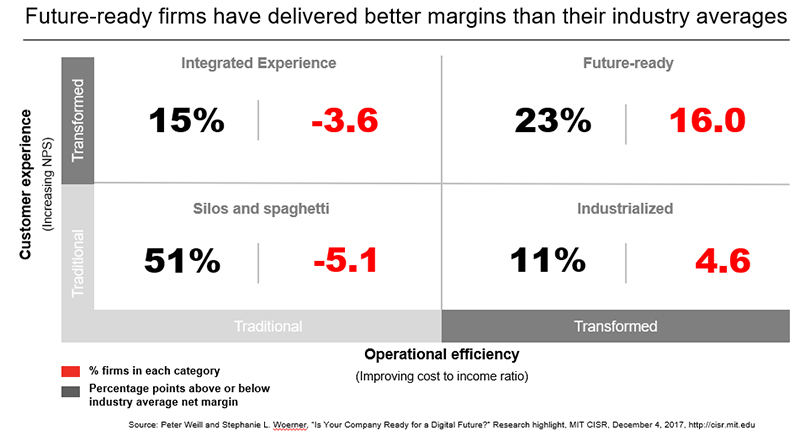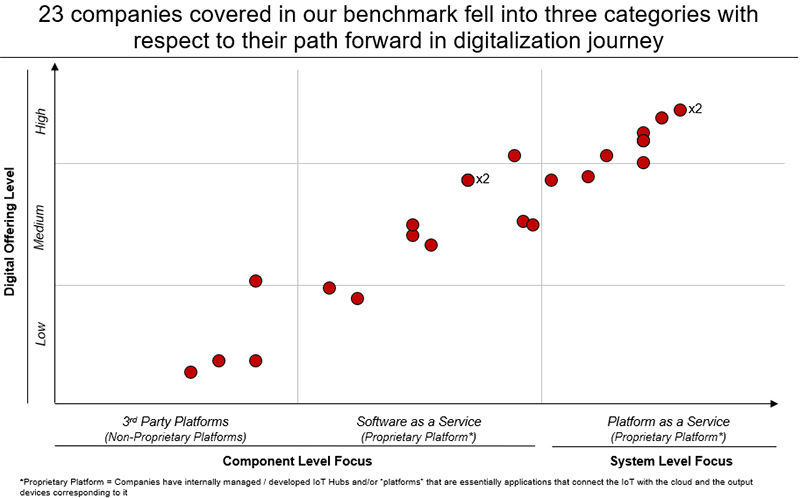The Digitalization Journey - Are You Future Ready?
In our journey to help our customers unlock the potential in their businesses, we have looked at 23 industrial companies to determine how to deliver the right digital footprint to our customers.
By Cummins Inc., Global Power Technology Leader

Is industrial market digitalization here to solve customers’ problems or to improve companies’ operational efficiency, or both? Enhancing the customer experience by solving customer problems is a key objective of digitalization. Hopefully, you have already read about five customer problems solved by digitalization in industrial markets. Yet this could be just half of the story.
According to recent research, companies that balance enhancing customer experience with improving their operational efficiency in their digital business transformation efforts perform better than their industry peers. These future-ready companies, top right quadrant of the chart below, have delivered an average net profit margin that is 16 points better than their industry average. Future-ready companies were able to not only solve key customer problems, but also concurrently reduce their costs or improve their efficiency.

Let’s narrow our focus onto companies serving industrial markets that use power systems (defined here as engines or power generators) as primary or emergency back-up power sources. For this purpose, we have explored how these companies take different paths forward in their digitalization journey. Our benchmark included 23 industrial companies and found out that these companies generally fall into three categories:
1. Companies that take a System Level approach and are trying to create the Operating System (OS) for the Internet of Things (IoT). Let’s call this model, “Platform as a Service.” These companies market their platform not only to their customers, but also to other companies. They expect other companies will develop applications to solve customer problems with their platform as a service.
2. Companies that take a Component Level approach and create proprietary platforms. Let’s call this model, “Software as a Service,” or SaaS. These companies focus their expertise around their products and services and aim to create solutions for customers in their core businesses. The focus is on the application, like an app for the operating system of a smart device.

3. Companies that take a Component Level approach and leverage third party platforms to offer digital solutions to their customers. These companies are customers of the companies in the first category. They may brand the solution as their own, but it is built on another platform.
Component Level digitalization serves to improve the reliability, availability, and operating cost of physical assets. Varying levels of sophistication exists across component level solutions. Basic level solutions feature sensors to monitor health and viability of the assets while enabling basic detection and diagnostic capabilities. The more advanced solutions leverage data and analytics to plan component level maintenance and to proactively identify advanced performance issues.
System Level digitalization serves to improve broader system processes and operations. These improvements could be flexible and scalable production, higher production yields and quality, and improved throughput and supply chain agility. Less advanced solutions leverage real-time data and analytics on products to increase process visibility and transparency, better allocate resources and increase overall production and supply chain performance. More advanced solutions leverage data and analytics to manage a broader set of operations, from fleet management to asset collaboration, and/or personnel to optimize the overall business performance. More advanced solutions could deliver improved safety, improved asset utilization, reduced asset base for same throughput, reduced labor expense, and more.
As companies embark on their digital transformation journeys, a balance between solving key customer problems and improving operational efficiency would be the path to create successful customers and companies. For industrial markets that use power systems (engines or power generators) as primary or emergency back-up power sources, we believe the path forward entails seven key solution themes, which we will cover in a future update.
Author Profiles

Cummins Inc., Global Power Technology Leader
Cummins Inc., a global power leader, is committed to powering a more prosperous world. Since 1919, we have delivered innovative solutions that move people, goods and economies forward. Our five business segments—Engine, Components, Distribution, Power Systems and Accelera™ by Cummins—offer a broad portfolio, including advanced diesel, alternative fuel, electric and hybrid powertrains; integrated power generation systems; critical components such as aftertreatment, turbochargers, fuel systems, controls, transmissions, axles and brakes; and zero-emissions technologies like battery and electric powertrain systems and electrolyzers. With a global footprint, deep technical expertise and an extensive service network, we deliver dependable, cutting-edge solutions tailored to our customers’ needs, supporting them through the energy transition with our Destination Zero strategy. We create value for customers, investors and employees and strengthen communities through our corporate responsibility global priorities: education, equity and environment. Headquartered in Columbus, Indiana, Cummins employs approximately 70,000 people worldwide and earned $3.9 billion on $34.1 billion in sales in 2024.
Related Tags